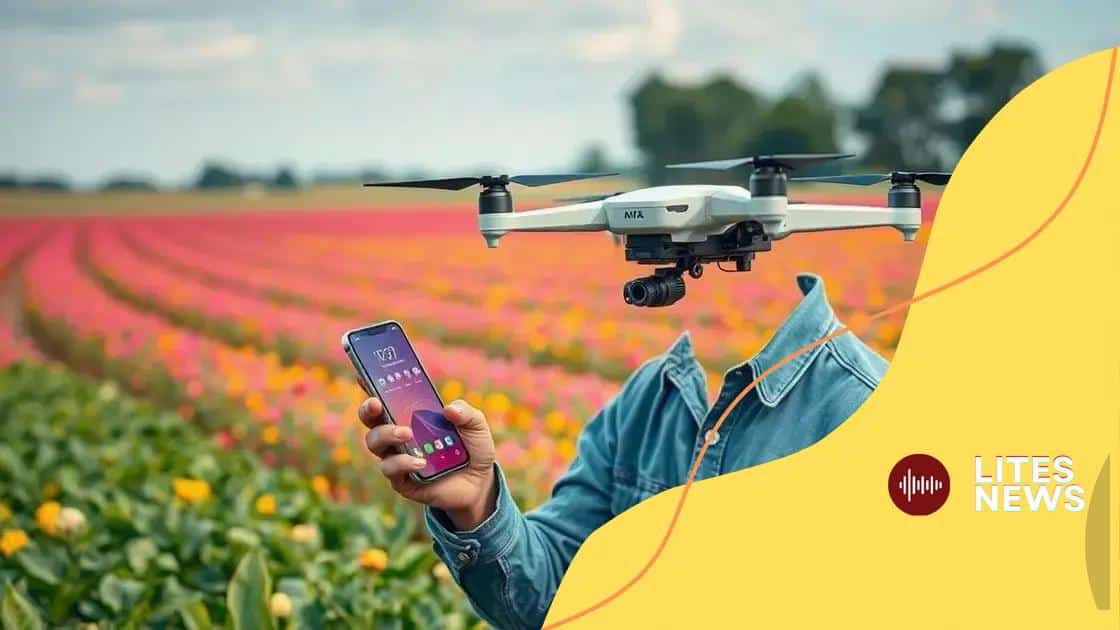Smart agriculture using IoT innovations for better yields

Smart agriculture using IoT innovations enhances farming efficiency, resource management, and sustainability by leveraging data-driven technologies to improve crop yields and optimize practices.
Smart agriculture using IoT innovations is changing the landscape of farming. Have you thought about how technology can help you grow more effectively? In this article, we’ll delve into how IoT is enhancing agricultural practices and what it means for the future of farming.
Understanding IoT in agriculture
To grasp the impact of IoT in agriculture, it’s essential to first understand what IoT means. The Internet of Things (IoT) connects various devices to the internet, allowing them to collect and share data. In farming, this means that sensors, drones, and other technological tools can work together.
How IoT Devices Work in Agriculture
IoT devices collect valuable information about the farming environment. They monitor soil moisture, temperature, and crop health in real time. This data helps farmers make quick and informed decisions.
- Soil Sensors: Measure moisture levels and nutrient content.
- Drones: Capture images for crop monitoring and health assessments.
- Weather Stations: Provide local weather updates to optimize farming activities.
By using these tools, farmers can enhance productivity and reduce waste. For instance, knowing exactly when to water crops cuts down on water usage. This smarter approach to farming promotes sustainability.
Benefits of Understanding IoT in Agriculture
Knowing how IoT works can be a game changer for farmers. It opens up new possibilities for efficiency and growth. Imagine a farm where every device communicates seamlessly, sharing relevant data with not just the farmer but also with other systems.
- Improved Yield: Utilizing data leads to better crop management and increased productivity.
- Cost Savings: Reduced input costs as resources are used more efficiently.
- Real-time Monitoring: Farmers can respond to issues on the spot, ensuring swift action.
The adoption of IoT technologies is not just about keeping up with trends. It’s about staying ahead in the game of agriculture. Farmers who understand these innovations can leverage them to enhance their operations.
As we explore more applications of IoT in agriculture, it becomes clear that the future lies in embracing these technologies. With the right knowledge, farmers can transform their practices, leading to not only better yield but also a more sustainable approach to agriculture.
Key benefits of IoT innovations
The key benefits of IoT innovations in agriculture are significant. These technologies are transforming the way farmers approach their work. By integrating IoT, farmers can make better-informed decisions that lead to increased productivity and resource efficiency.
Improved Efficiency
One of the most crucial benefits is improved efficiency. IoT devices help monitor various farm processes in real time. For example, farmers can track irrigation levels and soil moisture.
- Automated Irrigation: Systems can water crops only when needed, saving water.
- Remote Monitoring: Farmers can oversee their fields from anywhere, reducing travel time.
- Data Analytics: Insights from data can lead to optimized planting schedules.
With these advancements, farmers spend less time managing tasks and more time focusing on growth strategies. Integrating these systems allows farmers to respond to challenges quickly, minimizing losses and maximizing yields.
Cost Reduction
Understanding IoT innovations also leads to significant cost savings. With precise data, farmers can cut unnecessary expenses. This is particularly evident in:
- Resource Management: Identifying the right amount of water and nutrients needed.
- Energy Savings: Systems that optimize power consumption.
- Preventive Maintenance: Reducing equipment failures through timely alerts.
These advantages contribute directly to profitability. When farmers reduce input costs, they can reinvest in their operations. Moreover, lower operational costs enable competitive pricing in the market.
The use of IoT technologies fosters sustainability. By monitoring resource use, farms can operate in a more environmentally friendly manner. This not only benefits the planet but also appeals to eco-conscious consumers.
As farmers increasingly adopt these technologies, understanding their benefits becomes essential. Embracing IoT innovations in agriculture addresses modern challenges while ensuring a brighter future for farming practices.
Real-world applications of smart farming

Exploring real-world applications of smart farming reveals how technology is reshaping agricultural practices. Farmers across the globe are adopting innovative solutions to enhance productivity and sustainability.
Precision Agriculture
This approach utilizes data to optimize farming practices. Farmers can use GPS technology to map fields accurately. This mapping allows them to:
- Apply fertilizers and pesticides efficiently: Targeting specific areas reduces waste and increases effectiveness.
- Monitor crop health: Drones and satellite imagery provide vital information about crop conditions.
- Manage resources better: Data on soil conditions helps in determining the best planting times.
By harnessing precision agriculture, farmers can grow healthier crops and reduce environmental impact.
Automated Irrigation Systems
Automated irrigation is another remarkable application. Smart sensors detect when crops need water and adjust the irrigation system accordingly. This technology offers various benefits:
- Water Conservation: Reduces water waste by providing only what’s needed.
- Labor Savings: Less manual intervention means farmers can focus on other tasks.
- Improved Crop Quality: Consistent watering leads to healthier plants.
This innovation allows farmers to maintain optimal growing conditions even during dry spells.
In addition to these technologies, smart farming solutions also include livestock monitoring. Wearable devices track animal health and location. This data helps farmers ensure optimal care and improve overall livestock management. Farms can reduce disease outbreaks by monitoring health conditions quickly and implementing preventive measures.
Cultivating vertical farms is yet another advancement. These farms utilize stacked layers to grow crops, optimizing space and resources. Cities are increasingly adopting vertical farming to supply fresh produce locally, reducing transportation costs and environmental impact.
The integration of these smart farming practices is a testament to how agriculture continues to evolve. By embracing technology, farmers enhance efficiency, sustainability, and yield, paving the way for a more productive future.
Challenges in implementing IoT solutions
Despite the many advantages, there are significant challenges in implementing IoT solutions in agriculture. Farmers often face hurdles that can hinder the adoption of these innovative technologies.
High Initial Costs
One of the major obstacles is the high initial investment required. Setting up IoT systems can be expensive. Farmers need to purchase sensors, drones, and software. This upfront cost can be daunting, especially for small-scale farmers.
- Purchasing Equipment: High-quality devices can strain budgets.
- Installation Expenses: Professional installation may incur additional costs.
- Ongoing Maintenance: Regular updates and repairs can add to expenses.
Without access to sufficient funding or loans, some farmers may hesitate to adopt these technologies.
Lack of Technical Knowledge
An additional challenge is the lack of technical knowledge among farmers. Many agriculturists may struggle with learning how to use new technologies. This gap in understanding can lead to:
- Underutilization of Technology: Not exploiting IoT full potential can lead to wasted resources.
- Reluctance to Change: Fear of failing to adjust to new systems may deter adoption.
- Training Needs: Identifying proper training programs adds complexity.
Addressing these knowledge gaps is vital for successful implementation. Farmers need support and training to maximize their use of IoT solutions.
Another significant concern is data security. As farms gather more data, the risk of cyberattacks increases. Protecting sensitive information is crucial, especially as the industry moves toward more interconnected systems. Farmers may feel uncertain about data privacy and how to safeguard their operations against potential breaches.
Additionally, technological reliability can be a worry. IoT devices depend on stable internet connections, which may not always be available in rural areas. Interruptions in connectivity can disrupt farm operations, making reliability a consistent concern.
Overcoming these challenges requires collaboration among technology providers, farmers, and governments, ensuring a smooth transition to smart agriculture. Awareness of potential issues can also lead to more effective solutions.
The future of agriculture with IoT
The future of agriculture is bright, especially with the integration of IoT technologies. These innovations promise to transform farming in ways that increase efficiency and sustainability.
Smart Farming Technologies
As we look ahead, smart farming technologies will play a crucial role. Farms will increasingly rely on sensors and connected devices to monitor every aspect of production. With real-time data, farmers can react quickly to changing conditions. This proactive approach allows:
- Accurate Resource Management: Using just the right amount of water and nutrients for crops.
- Predictive Analytics: Anticipating problems before they become severe.
- Enhanced Crop Yields: Optimizing growing conditions leads to more productive harvests.
Such advancements will lead to smarter, more resilient agricultural practices. With integrated systems, farmers will make decisions based on clear insights rather than guesswork.
Sustainability and Environmental Impact
One key focus of the future will be sustainability. IoT helps farmers reduce their environmental footprint by promoting better resource usage. Smart irrigation systems, for example, minimize water waste by delivering precisely what crops need. This smart management not only conserves water but also supports healthy ecosystems.
As farmers embrace these technologies, they can contribute to global sustainability goals. Many agro-tech companies are developing solutions aimed specifically at decreasing waste and optimizing production methods.
Another aspect is the use of drones and robotics. These tools will continue to evolve, allowing for tasks like planting seeds, monitoring crops, and applying fertilizers. This automation can lead to increased efficiency and reduced labor costs.
Moreover, potential advancements in AI and machine learning will drive further innovation. These technologies will analyze data to provide deeper insights into crop health and environmental factors. With this information, farmers can make even more informed decisions.
Collaboration between farmers, technologists, and researchers will be vital for harnessing the full potential of IoT in agriculture. As partnerships develop, new solutions can emerge, shaping the agricultural landscape of tomorrow.
FAQ – Frequently Asked Questions about Smart Agriculture and IoT Innovations
What are the main benefits of using IoT in agriculture?
The main benefits include increased efficiency, better resource management, and improved crop yields through data-driven decisions.
What challenges do farmers face when implementing IoT solutions?
Farmers often face high initial costs, a lack of technical knowledge, data security concerns, and issues with internet connectivity.
How do smart farming technologies promote sustainability?
They optimize resource usage, such as water and fertilizers, reducing waste and minimizing environmental impact.
What is the future outlook for agriculture with IoT technologies?
The future looks promising, with advancements in technology leading to more efficient, productive, and sustainable agricultural practices.





